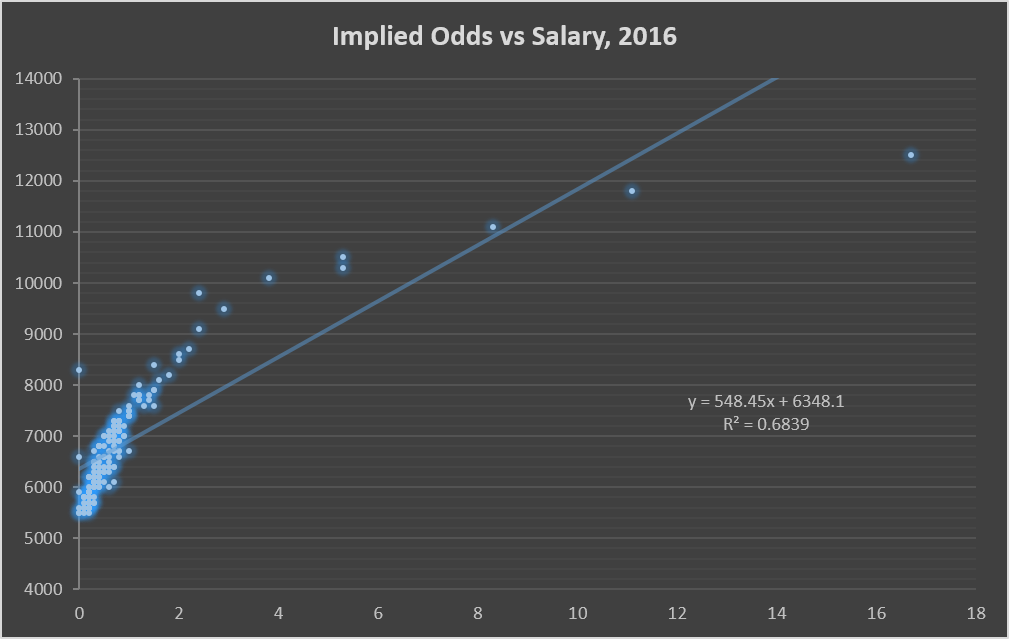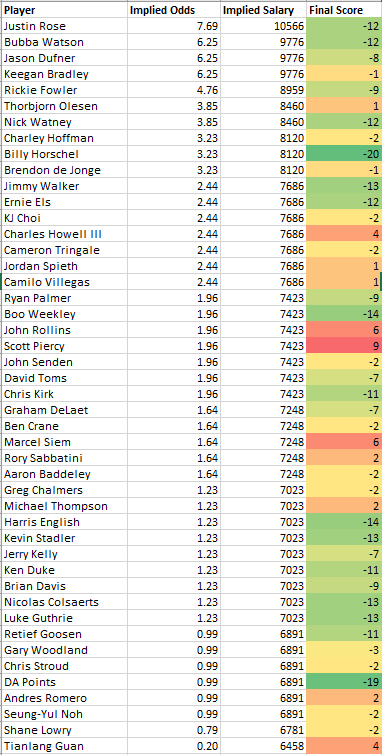I’m a big believer in our Plus/Minus metric here at FantasyLabs. The reason is that it easily shows value for a player or trend. Knowing that Stephen Curry scores more fantasy points on average than Jose Calderon is obvious and not very useful for daily fantasy sports. However, knowing which player scores more fantasy points on average relative to his salary is huge. Because DFS contests are built around salary caps, we have to include the value of salary in our data analysis.
However, there’s one issue with Plus/Minus: We have data only as far back as DFS sites like FanDuel and DraftKings have existed. It has been a couple years and the data isn’t too small of a sample, but what’s a couple of years of MLB DFS data for a league that has existed for 113 years (and even longer than that if you count the National League founding in 1876)?
We Are Fortunate: Retrodiction
Fortunately, for a sport like MLB, there are so many games per year that even a couple of years of data lends to large enough samples to make DFS data trustworthy. However, in a sport like PGA, that 1) hasn’t been around even as long as NFL and MLB DFS and 2) has much fewer data samples per year as compared to MLB and NBA, sometimes we have to dig into Plus/Minus and past data a little more.
Fortunately (again), we don’t need PGA to have existed as long or have as big of samples because of one important pricing quirk for PGA DFS at DraftKings: The very strong correlation between implied Vegas odds of a tournament and a player’s salary. Of course, it’s not a perfect correlation — DraftKings factors in recent play, course history, and other factors — but it’s strong enough that we could perhaps retrodict player salaries for tournaments that occurred before DraftKings even existed and, in doing so, further strengthen our findings of what stats are most important for players at a particular course and even for a particular salary tier.
Let’s look at this week’s Zurich Classic of New Orleans as an example. I plotted the implied odds and salaries of each player in the field this week and got a line of best fit to use for salary retrodiction.

Again, it’s not a perfect correlation and, as a result there will be error on either side that we should remember. One specific error I noticed right off the bat was that, because most of the golfers in the field have such low odds of winning, our formula fits them much better than a player with high odds, like Jason Day (who had 16.7 percent implied odds this weekend).
Re-applying our formula right back to this field, we can see that it generally fits (or, for the purpose of this article, “predicts salary” for) players within a couple hundred dollars. However, the formula predicts that Jason Day, priced at $12,500, should be around $15,500 (according to the distribution of Vegas odds at this tournament).
Quick side note: I think Day’s predicted salary is really interesting and possibly hints that the top players are probably a bit underpriced relative to the field, although I’d have to do this study for a large sample of tournaments to know for sure.
Exploring the 2013 Zurich Classic of New Orleans
Next, we can pull Vegas odds for a past tournament and apply our formula to retrodict salaries. Here are the results I compiled for the 2013 Zurich Classic of New Orleans (click to enlarge).

Now here is where we are required to do a lot of manual work and some conjecture. It is difficult to find a player’s stats — Driving Distance, Greens in Regulation, Driving Accuracy, Putts Per Round, and so on — at the time of the beginning of the 2013 Zurich Classic. Our options then are to apply statistics we have currently for a player (which will be accurate for some players and perhaps not for others) or to do our best to interpret the data on a player-by-player basis. I think the latter might be best in this regard, although I’m not opposed to the former option if someone wanted to do it.
I would probably do this by looking at young golfers vs. older ones. As CSURAM88 has mentioned on our PGA Daily Fantasy Flex pod multiple times, younger players are much more likely to have stark improvement. For a player like Charley Hoffman, who has been on the PGA Tour since 2006, I’m more willing to apply his current long-term stats in our Player Models to the 2013 retrodiction data above, since who he is as a player now is probably very similar to who he was three years ago.
However, Jordan Spieth joined the PGA Tour in 2013 and the Zurich Classic was just a few tournaments into his career. For him, I wouldn’t blindly apply his current stats. I would instead look at his situation a bit deeper to discover what sort of player he was starting off versus now.
Is Retrodiction the Future of PGA DFS?
This is more of an exploratory article, although I think that the topic discussed could be a large project in the future. I derived my formula from the Zurich Classic of New Orleans. If we were to do this on a larger scale for all tournaments, we should adapt our formula accordingly. Doing so might resolve the Jason Day issue stated above, although I still think that’s a very interesting caveat for this week.
Is retrodiction an exact science? Of course not, although it can help fill in the missing gaps that we find with the small sample size of DraftKings PGA data.





